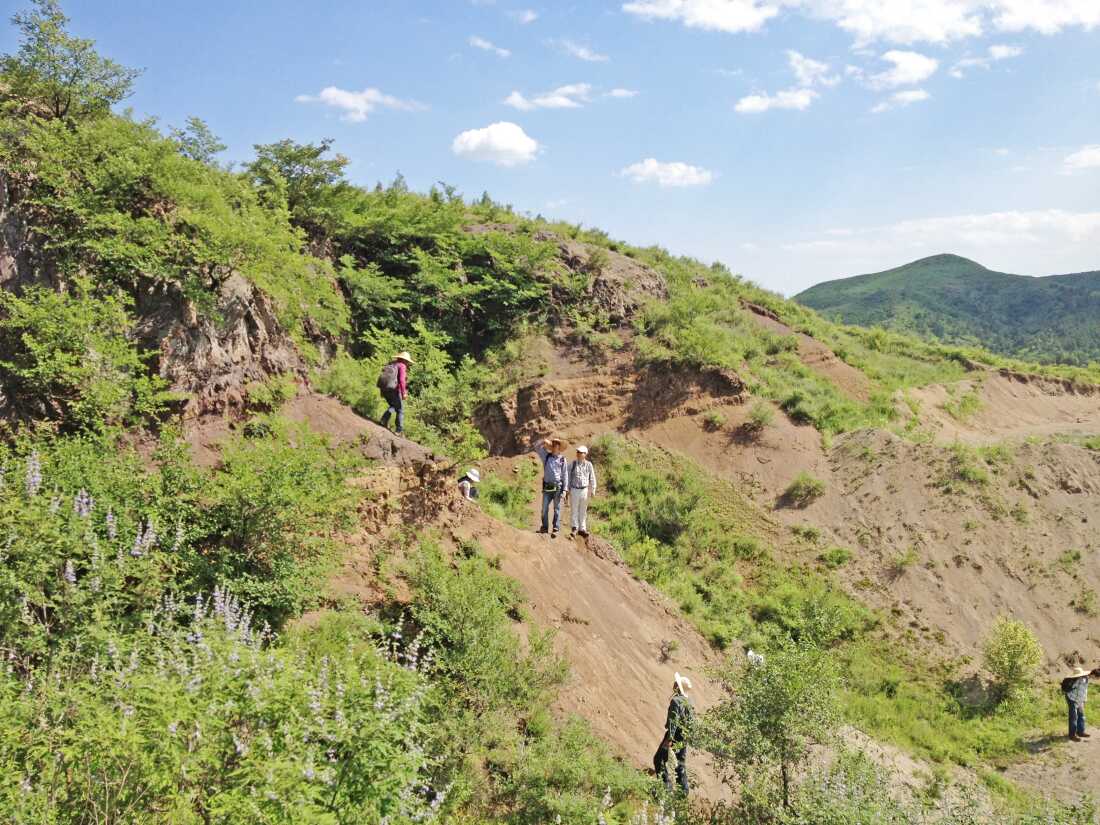Bu içerik, Çin’deki Yixian Formasyonu’nda bulunan dinozor fosilleri hakkında bilgi vermektedir. Columbia Üniversitesi’nden bir jeolog olan Paul Olsen ve meslektaşları, bu fosillerin olağanüstü korunmasının volkanik aktiviteden ziyade, zamanla kazılmış tünellerin çökmesinden kaynaklandığını savunmaktadır. İki Psittacosaurus dinozorunun üç boyutlu fosillerinin incelenmesi sonucunda bu teori desteklenmektedir. Diğer araştırmacılar ise bu yeni değerlendirmeye şüpheyle yaklaşmaktadır. Olsen’a göre, derin göllerin tabanında diğer hayvanların gömüldüğü çamurların içinde volkanik aktiviteye gerek yoktu. Sonuç olarak, Olsen, derin geçmişi anlamaya çalışırken olağanüstü felaket olayları hakkında hikayeler uydurmaktan kaçınılması gerektiğini vurgulamaktadır.
Kaynak: www.npr.org

Two complete skeletons of the dinosaur Psittacosaurus from one of the sites analyzed by the research team. Some scientists say these fossils show evidence of preservation due to their burrows collapsing.
Liu Jun
hide caption
toggle caption
Liu Jun
For decades, a few hundred miles northeast of Beijing, the Yixian Formation has offered up a treasure trove of exquisite dinosaur fossils dating back to the early Cretaceous (about 145 to 66 million years ago).
“It gives us this extraordinary window into the past and into this time where there were very diverse dinosaurs,” says Paul Olsen, an earth scientist at Columbia University. “We’re looking at this snapshot of an ecosystem.”
Most researchers have said the remarkable preservation of many of these specimens was due to volcanic activity. But in research published in the journal PNAS, Olsen and his colleagues argue an alternative explanation — that, over time, their burrows collapsed, suffocating them. This would have happened repeatedly over some 90,000 years.
“In no way does this diminish these fantastic fossils,” says Olsen. “In fact, for me, it makes them even more marvelous that we get this deep view of diversity so many millions of years ago.”

The Nanjing Institute of Geology and Paleontology team at a site where many three-dimensional dinosaur fossils have been excavated.
Paul Olsen
hide caption
toggle caption
Paul Olsen
A Chinese Pompeii?
The Yixian Formation has yielded a stunning array of fossils over the years. “It’s produced the majority of the spectacular feathered dinosaurs of China,” says Olsen. These flattened fossils are very well preserved.
There’s also a whole suite of 3-dimensional fossils of both carnivorous dinosaurs and plant-eating dinosaurs, “which include distant relatives of animals like triceratops,” Olsen says. “They’re astoundingly complete down to the very, very last bone. And they’re often in positions that look like they were just frozen in an instant.”
It’s this appearance, combined with the deposits being rich in volcanic ash, that has led many researchers to conclude, “that the animals were catastrophically entombed by either volcanic mud flows or killed by volcanic ash or some sort of major catastrophe,” says Olsen.
But that didn’t really make sense to Olsen. He reflected on the people who died in Pompeii when Mount Vesuvius erupted and quickly buried the city. “They are in really contorted positions that tell you they were in extreme discomfort when they died,” says Olsen. “They’re all bunched up and they have their fists clenched.”
Many of the dinosaur fossils unearthed in this part of China, however, look like they’re sleeping peacefully. There are no visible signs of discomfort from fiery volcanic activity.
Paleontologists have also found clutches of baby dinosaurs clustered together. “How would those animals ever stay together if they were enveloped in a massive flowing mass of material?” asks Olsen. “It’s not a mystery what happens to organisms when they get caught up in these things. They get ripped to shreds.”
A different view
Olsen and his colleagues studied the sediment surrounding and inside two three-dimensional fossils of Psittacosaurus. “The sediment inside the animal in both dinosaurs was much finer grained than the sediment outside of it,” he says.
That observation indicated to Olsen that the animals were buried with their skin and muscles still intact, since the flesh would have only allowed fine grained material to flow slowly into the body cavity, filtering out anything coarse. Olsen and his collaborators argue that such a burial would not have been the result of catastrophic volcanic flows. He says burrow collapse is a more straightforward conclusion.
“Maybe some of them collapsed because a big sauropod dinosaur walked by,” says Olsen. “Or maybe it was an earthquake. Or maybe it was just the water-logged mud simply collapsed.”
Olsen says that other animals were likely entombed in sediments at the bottom of a series of deep lakes. No volcanic activity would have been required there either.
But some researchers are skeptical of the new assessment.
“The paper is good,” says Baoyu Jiang, a paleontologist at Nanjing University who wasn’t involved in the research. “But they only analyzed two dinosaur fossils. They even didn’t study the fossil in the lake.” Olsen disputes this, explaining that he and his colleagues did analyze ash samples from the lake sediments.
Jiang finds the results unconvincing and speculative. “Sometimes you find fossils in normal sediment like they found,” he says. “But most of the time, the feathered dinosaurs, they were preserved closely associated with volcanic ashes. There are many kind of possibilities.”
For Olsen, the takeaway is straightforward.
“We should be careful in our attempts to understand the deep past not to make up stories that involve extraordinary catastrophic events,” he says, “when, in fact, very simple mundane ones can explain the same thing.”







Yorumlar kapalı.